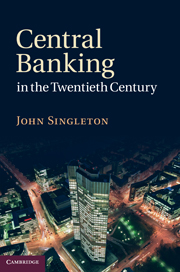Book contents
- Frontmatter
- Contents
- List of illustrations
- Acknowledgements
- List of abbreviations
- 1 A beginner's guide to central banking
- 2 Very boring guys?
- 3 Wind in the willows: the small world of central banking c. 1900
- 4 Something for everyone: new central banks, 1900–1939
- 5 A series of disasters: central banking, 1914–1939
- 6 The mysteries of central bank cooperation
- 7 The first central banking revolution
- 8 No time for cosmic thinkers: Central banking in the ‘Keynesian’ era
- 9 Rekindling central bank cooperation in the Bretton Woods era
- 10 The goose that lays the golden egg: Central banking in developing countries
- 11 The horse of inflation
- 12 The second central banking revolution: Independence and accountability
- 13 Reputations at stake: financial deregulation and instability
- 14 Inflation targeting: the holy grail?
- 15 The long march to European monetary integration
- 16 A world with half a million central bankers
- References
- Index
6 - The mysteries of central bank cooperation
Published online by Cambridge University Press: 04 February 2011
- Frontmatter
- Contents
- List of illustrations
- Acknowledgements
- List of abbreviations
- 1 A beginner's guide to central banking
- 2 Very boring guys?
- 3 Wind in the willows: the small world of central banking c. 1900
- 4 Something for everyone: new central banks, 1900–1939
- 5 A series of disasters: central banking, 1914–1939
- 6 The mysteries of central bank cooperation
- 7 The first central banking revolution
- 8 No time for cosmic thinkers: Central banking in the ‘Keynesian’ era
- 9 Rekindling central bank cooperation in the Bretton Woods era
- 10 The goose that lays the golden egg: Central banking in developing countries
- 11 The horse of inflation
- 12 The second central banking revolution: Independence and accountability
- 13 Reputations at stake: financial deregulation and instability
- 14 Inflation targeting: the holy grail?
- 15 The long march to European monetary integration
- 16 A world with half a million central bankers
- References
- Index
Summary
Events so moved as to bring … central bankers together, sometimes face to face, more often in correspondence by letter and cable or on the telephone, in repeated attempts to resolve international monetary problems.
S. V. O. Clarke (1967: 17)Between all 4 [of us] much talk and increased personal understanding & friendliness. But, sooner or later fundamental differences of position … CBk cooperation melancholic[,] rather a pretence! than deep reality.
Montagu Norman, 1927 (Sayers 1976, vol. III: 98–9, 100)Montagu Norman, the leading proponent of cooperation amongst central bankers in the 1920s, judged the response of some of his peers to be rather lukewarm and superficial. Nowadays central bank cooperation is taken for granted. Central banks exchange information, opinion, advice, and personnel. They provide each other with banking facilities. They may even coordinate their policies, for example in the spheres of prudential supervision and exchange rate management. Central bankers meet regularly at international conferences, and are served by their own trade journals, including Central Banking, as well as by specialist academic publications such as the International Journal of Central Banking. One hundred years ago, however, there was very little interaction between central banks. This chapter examines the history of central bank cooperation up to 1939, discusses the motives for cooperation (and non-cooperation), and assesses the record of achievement and failure. As space is not available for a comprehensive narrative of events, readers in search of this level of detail are referred to Sayers (1976), Eichengreen (1992a), Clarke (1967), Meyer (1970), and Toniolo (2005).
- Type
- Chapter
- Information
- Central Banking in the Twentieth Century , pp. 91 - 109Publisher: Cambridge University PressPrint publication year: 2010



